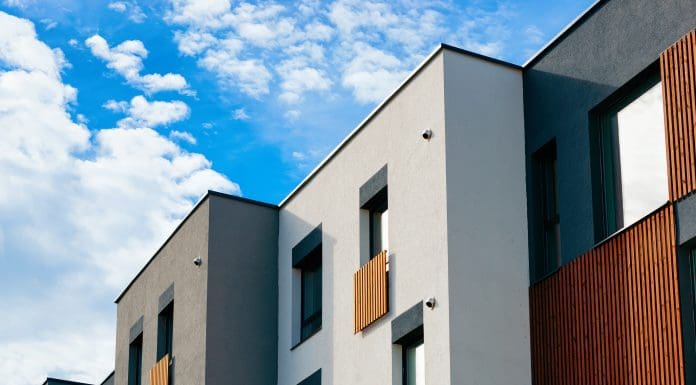Housebuilders must look for practical solutions as the industry faces hefty housebuilding targets, tight budgets and programmes, and the need for sustainability
Combining the precision and efficiency of modern, offsite construction methods with the reliability and craftsmanship of other methods for hybrid-built homes makes sense. But what exactly are hybrid-built homes, and why should developers and housing providers take notice?
What are Hybrid Built Homes?
Hybrid construction blends materials and traditional, on-site building methods with offsite techniques like modular construction. Unlike purely modular homes, which can be considered rigid in design, hybrid construction allows you to customise projects for a tailored approach that meets specific aesthetic, structural, and functional requirements.
We’ve written about and consistently championed hybrid construction through our M-Dock pod and panel system. It is designed to work with any method and bring a balanced, integrated solution to housing projects.
Where modular fails, hybrid prevails.
Modern Methods of Construction (MMC) can be a game-changer, promising faster builds, reduced costs, and improved quality. MMC definitely has its place when delivering housing at speed. However, specific methods are seen as rigid they can sometimes lead to repetitive designs that lack the flexibility to meet varied aesthetic or structural needs.
Concerns about supply chain dependencies and the need for extensive upfront investment in factory facilities, can be a barrier for smaller developers.
Hybrid construction answers these concerns by integrating the benefits of MMC with the adaptability of other site methods. It allows developers to use prefabricated components where they make sense—speeding up the build and ensuring quality—while retaining the flexibility to adapt and customise on-site elements.
Flexibility in design and build
Versatility is one of the most compelling reasons to consider hybrid construction as it enable designs to be adapted more freely. Prefabricated components can be blended seamlessly with brickwork, SIPs or other materials, providing the opportunity to create distinctive, high-quality homes that would be difficult to achieve with modular construction alone.
This flexibility extends beyond aesthetic as diverse materials and techniques helps you adapt to site conditions, architectural styles, and client need.
Speed, efficiency, and cost savings
When we have 375,000 homes to build in 12 months, one of the strongest arguments for hybrid construction is speed. Manufacturing certain elements offsite streamlines the construction process. When you can prepare components offsite, it cuts down on variables like weather and other delays, giving projects a smoother, faster pathway to completion. These efficiencies can help you respond to labour shortages, minimises disruption, and shortens project programmes.
Speed isn’t just about time saved—it also translates into cost savings. Efficient use of materials, reduced labour costs, and shorter project durations mean hybrid construction can offer significant economic benefits. Developers can see faster returns on investment and reduced interest payments on financing.
Quality, durability, and sustainability
Components produced in controlled factory environments often result in higher quality. Hybrid construction combines these high-spec components with traditional building elements, ensuring robust, durable homes that stand the test of time. The M-Dock system exemplifies how modern materials and manufacturing processes can deliver homes that look good and perform exceptionally well in the long term.
Like offsite, this method is also highly sustainable. Factory processes result in less waste and integration of offsite-built elements reduces emissions from site traffic. Helping you the project’s and your carbon footprint, and making hybrid builds an environmentally responsible choice.
Enhanced safety and reduced risk
Safety on construction sites remains a critical concern, and hybrid construction mitigates many of these risks by moving more of the work offsite. Controlled factory settings minimise the potential for accidents and allow for safer working conditions. Additionally, having fewer trades on-site reduces the chances of delays caused by weather or logistical challenges, creating a smoother build process overall.
The future-proof appeal of hybrid homes
Hybrid construction is adaptable. Homes built using a hybrid approach are more easily modified or extended, making them ideal for developers who want to plan for future flexibility. Whether incorporating new technologies, aiming for reduced energy bills and net zero or adapting to changing family needs, hybrid homes can evolve in ways that traditional builds often struggle to accommodate.
More enthusiasm for hybrid methods, please
The future of housing construction is not just about speed or cost; it’s about balancing efficiency, quality, and sustainability. Hybrid construction offers a way to do just that. Combining traditional craftsmanship with modern manufacturing, hybrid-built homes represent the next step in housing innovation.
We’ll continue to advocate for a shift to more hybrid-built houses and help bring projects to life that are faster, more efficient, and better in every sense. We want to see more of the sector join us.
If you want to explore the benefits of hybrid construction, contact us at Sano. Let’s build better homes together.
The post The need for hybrid-built homes continues to grow appeared first on Planning, Building & Construction Today.


